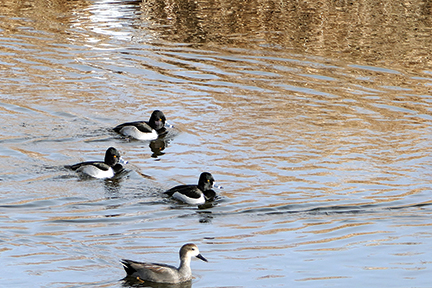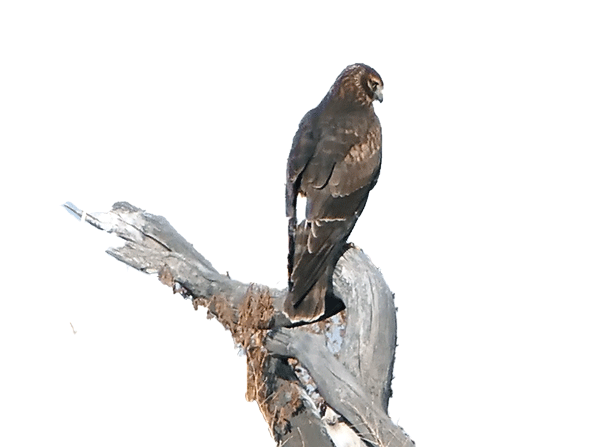
A hardy group of citizen scientists started off the new year with a 122-year-old tradition. Despite single digit temperatures and a coating of snow on the trails, they set out Jan. 1 along a route that was added to the National Audubon Society’s Christmas Bird Count (CBC) in the late 1990s.
The outing had a “bubby New Year’s vibe,” said Casey Davenhill, a Denver Audubon volunteer who has led the bird count in this area since “South Platte Central” was added to the project. Davehill’s group made its way along the South Platte River starting at City of Cuernavaca Park. They headed through Riverside Cemetery and on to Commons Park and Confluence Park. Then, they hopped up to Globeville Landing Park and Northside Park near 51st Avenue and Franklin Street.
Their job was to identify and count as many birds as they could find. According to Davenhill, the cold temperature meant many birds would be hunkered down and hidden. But the river is a good place to spot birds this time of year. Birds need water, and other urban water sources like ponds and bird baths can be frozen over.

One of the first birds the trained eyes of Davenhill’s group found was a Cooper’s hawk. Then, on the water, hooded mergansers and goldeneyes, mallards and gadwalls. A red-shafted flicker made an appearance, as did a song sparrow and junco. And of course, a dozen crows. The 15 species and 408 individual birds (plus or minus a few geese) will be added to a national database with records going back to 1900. It’s the longest running citizen science survey in the world.
“Count days” take place annually in sub-areas like Davenhill’s from Dec. 18 through Jan. 5. Each sub-area is a fraction of its larger 15-mile diameter “circle.” National Audubon tracks birds in 122 circles extending north and south across the Americas and as far west from here as Guam. North Denver bumps up against the edges of the metro area’s three circles: Denver Urban CBC, Denver CBC and North Jeffco.
CBC data has informed Audubon’s climate change and birds in decline reports, as well as other studies by the Environmental Protection Agency and the North American Bird Conservation Initiative of the U.S. Fish &
Wildlife Service.
But Big Data was pretty far from the mind of CBC founder Frank Chapman back in 1900. He was instead determined to create a bird-friendly alternative to something called the Christmas Side Hunt. The side hunt was a popular hunting competition in the northeast that some were beginning to believe killed more birds and mammals—in the name of competition—than humans could reasonably make good use of. Chapman proposed a bird appreciation event: a census-slash-walkabout. The first CBC brought out 27 observers in 25 locations, spotting 90 species of birds.
Back along the South Platte, on Dec. 18 in a sub-area to our south, a group led by Denver Field Ornithologists (DFO) volunteers Ed Holub and Jill Boice spotted 33 species totaling 927 individual birds. The Denver CBC circle has grown from around 30 observers in 1954 to 180 in 2017. Some years they’ve counted over 100 species and as many as 40,000 individual birds.
And species trends are worth noting, says Denver Audubon’s Hugh Kingery. Kingery, once referred to by the Denver Post as the Dean of Colorado birding, reports the Denver Urban CBC has seen significant increases in bald eagles, red-tailed hawks, and several other birds (including crows, as we’ve evidenced in North Denver). Meanwhile, they’ve seen decreases in non-native birds like house sparrows, european starlings and rock pigeons.
The South Platte River is the perfect place for novice and experienced birders alike. According to Boice and Davenhill, waterfowl stay put longer and their distinctive features help you tell them apart. But Davenhill may be a touch biased. She’s been working with the river since the days of former Mayor Wellington Webb’s South Platte River Commission. And now she’s Executive Director of Colorado Watershed Assembly. She’s led groups of youth along the river, “seeding and weeding,” observing how it’s grown up.
Boice recently birded a stretch of the South Platte near East 64th Avenue and York Street, near the Robert W. Hite Water Treatment Facility. The temperate water flowing from the facility attracts a volume and variety of birds you won’t see elsewhere, especially during the winter. Her two-hour outing clocked 34 species (550+ birds), including black-crowned night herons and great blue herons, double-crested cormorants, northern pintails, and ring-necked ducks. And along the banks and in nearby trees and fences: a northern harrier, chickadees, sparrows, starlings, finches and a singular stunning Say’s phoebe.
Boice plans to repeat this outing as a field trip leader for Denver Field Ornithologists beginning Feb. 7. She’ll bring an extra pair of binoculars to share. Birders are like that: inviting and sharing, observing and identifying, smiling and pointing at every interesting bird they encounter. With humans like this involved, the Christmas Bird Count seems safe to continue on for another 122 years.
Visit these websites to step up your own birding: birds.cornell.edu/citizenscience; dfobirds.org; denveraudubon.org

Please note that the Christmas Bird Count in 2020 included 2,459 circles during the 121st Christmas Bird Count, with 1,842 counts in the United States, 451 in Canada (including St. Pierre et Miquelon), and 166 throughout Latin America, the Caribbean, and the Pacific Islands.